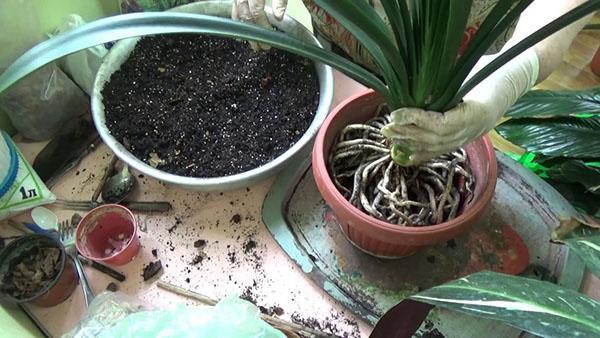Clivia transplant: topical tips
 Clivia is transplanted when the root system has completely filled the pot and begins to "break out" out. The procedure must be completed before the dormant period, which will fall in September.
Clivia is transplanted when the root system has completely filled the pot and begins to "break out" out. The procedure must be completed before the dormant period, which will fall in September.
Vallotta cinnabar (another name) is a South African culture. Long seasons of calm are observed in its life cycle. Thanks to them, she can recover and delight the owners with her flowering.
Painstaking clivia transplant
On the eve or 5 hours before the planned procedure, the flowerpot is watered abundantly. If such irrigation does not give the desired results, then the pot is immersed in a bucket of water. The lump should be saturated with liquid and soften so that it can be pulled out without problems. Next, they do several delicate operations:
- the blunt side of the knife is held between the pot and the ground;
- carefully pull the bush so as not to damage the roots, because then they will begin to rot;
- washed again by placing the flowerpot in a bucket of water (room temperature), and start dipping until all the soil is washed off;
- gentle movements straighten and separate the rhizomes of the seedlings;
- leave them to dry out a little;
- places of cuts that were formed during tearing are treated with activated carbon.
Clivia is transplanted at an early age. It is very problematic to work with ten year olds. Their roots are so tangled that it is impossible to separate them without damage. Therefore, some simply renew the top layer by bringing in loose soil (5 cm).
Then they take a pot and fill it with expanded clay, dry manureas well as a universal primer. It is important to remember that the culture loves slightly acidic soil. After that the seedling is tried on. The root collar should be level with the edge of the container.
Then the roots are sprinkled with planting earth. Shake the flowerpot so that there are no air voids. The belt-like leaves are carefully wiped from dust, and the flower itself is watered abundantly, slightly pressing the soil. Be sure to cut the peduncle, otherwise it will take away the strength that is needed for the development of a new plant.
Recovery period
After such a "barbaric" procedure, the culture needs to be restored. For this, favorable conditions are created. A newly baked seedling is placed in a warm place at a temperature of 20-25 ° C. And only after 2 months, when he gets stronger, he is transferred to a cool room - a rest zone (14-15 ° C). Among other things, before planting, the soil is disinfected:
- in the oven for about 10 minutes;
- in the microwave for up to 3 minutes at the optimum temperature;
- using a solution of potassium permanganate;
- scalded with boiling water.
Each of the voiced methods allows you to destroy pathogenic bacteria that are in the ground. Such a clivia transplant can be considered successful, because growers can get up to 9 young specimens from one dense bush.